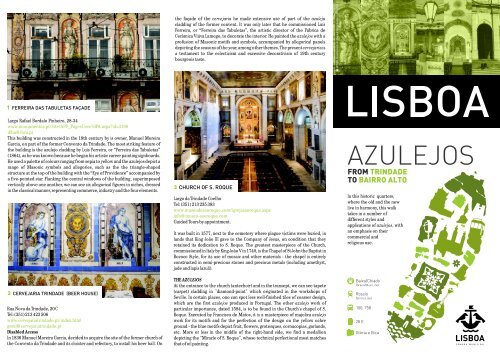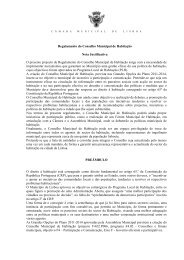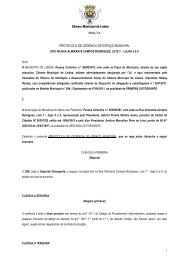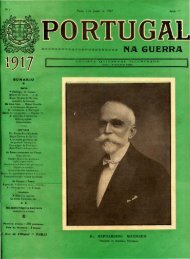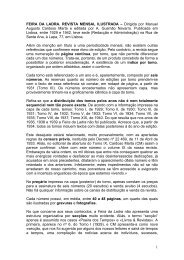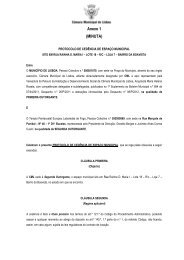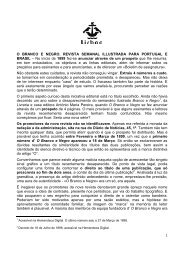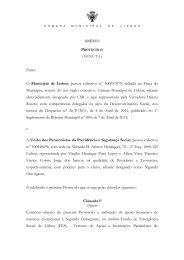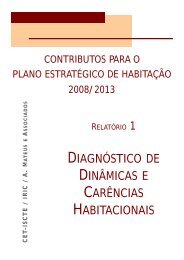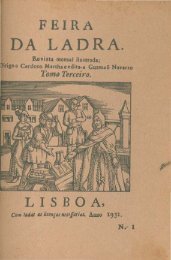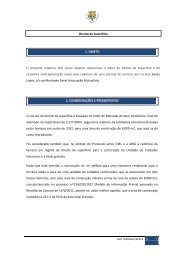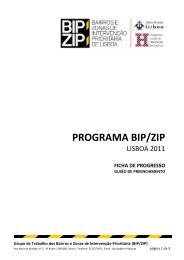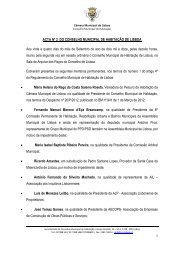Largo Rafael Bordalo Pinheiro, 28-34 This building was constructed ...
Largo Rafael Bordalo Pinheiro, 28-34 This building was constructed ...
Largo Rafael Bordalo Pinheiro, 28-34 This building was constructed ...
Create successful ePaper yourself
Turn your PDF publications into a flip-book with our unique Google optimized e-Paper software.
<strong>Largo</strong> <strong>Rafael</strong> <strong>Bordalo</strong> <strong>Pinheiro</strong>, <strong>28</strong>-<strong>34</strong><br />
www.monumentos.pt/Site/APP_PagesUser/SIPA.aspx?id=3190<br />
diba@ihru.pt<br />
<strong>This</strong> <strong>building</strong> <strong>was</strong> <strong>constructed</strong> in the 19th century by is owner, Manuel Moreira<br />
Garcia, on part of the former Convento da Trindade. The most striking feature of<br />
the <strong>building</strong> is the azulejo cladding by Luís Ferreira, or “Ferreira das Tabuletas”<br />
(1864), as he <strong>was</strong> known because he began his artistic career painting signboards.<br />
He used a palette of colours ranging from sepia to yellow and the azulejos depict a<br />
range of Masonic symbols and allegories, such as the the triangle-shaped<br />
structure at the top of the <strong>building</strong> with the “Eye of Providence” accompanied by<br />
a five-pointed star. Flanking the central windows of the <strong>building</strong>, superimposed<br />
vertically above one another, we can see six allegorical figures in niches, dressed<br />
in the classical manner, representing commerce, industry and the four elements.<br />
Rua Nova da Trindade, 20 C<br />
Tel: (351) 213 423 506<br />
www.cervejariatrindade.pt/index.html<br />
geral@cervejariatrindade.pt<br />
Disabled Access<br />
In 1836 Manuel Moreira Garcia, decided to acquire the site of the former church of<br />
the Convento da Trindade and its cloister and refectory, to install his beer hall. On<br />
the façade of the cervejaria he made extensive use of part of the azulejo<br />
cladding of the former convent. It <strong>was</strong> only later that he commissioned Luís<br />
Ferreira, or “Ferreira das Tabuletas”, the artistic director of the Fábrica de<br />
Cerâmica Viúva Lamego, to decorate the interior. He painted the azulejos with a<br />
profusion of Masonic motifs and symbols, accompanied by allegorical panels<br />
depicting the seasons of the year, among other themes. The present cervejaria is<br />
a testament to the eclecticism and excessive decorativism of 19th century<br />
bourgeois taste.<br />
<strong>Largo</strong> da Trindade Coelho<br />
Tel: (351) 213 235 383<br />
www.museudesaoroque.com/igrejasaoroque.aspx<br />
info@museu-saoroque.com<br />
Guided Tours by appointment.<br />
It <strong>was</strong> built in 1577, next to the cemetery where plague victims were buried, in<br />
lands that King João III gave to the Company of Jesus, on condition that they<br />
retained its dedication to S. Roque. The greatest masterpiece of the Church,<br />
commissioned in Italy by King João V in 1740, is the Chapel of St John the Baptist in<br />
Rococo Style, for its use of mosaic and other materials - the chapel is entirely<br />
<strong>constructed</strong> in semi-precious stones and precious metals (including amethyst,<br />
jade and lapis lazuli).<br />
THE AZULEJOS<br />
At the entrance to the church (antechoir) and in the transept, we can see tapete<br />
(carpet) cladding in "diamond-point" which originated in the workshops of<br />
Seville. In certain places, one can spot less well-finished tiles of coarser design,<br />
which are the first azulejos produced in Portugal. The other azulejo work of<br />
particular importance, dated 1584, is to be found in the Church's chapel of S.<br />
Roque. Executed by Francisco de Matos, it is a masterpiece of majolica azulejo<br />
work for its motifs and for the perfection of the design on the yellow ochre<br />
ground - the blue motifs depict fruit, flowers, grotesques, cornucopias, garlands,<br />
etc. More or less in the middle of the right-hand side, we find a medallion<br />
depicting the "Miracle of S. Roque", whose technical perfectional most matches<br />
that of oil painting.<br />
In this historic quarters,<br />
where the old and the new<br />
live in harmony, this walk<br />
takes in a number of<br />
different styles and<br />
applications of azulejos, with<br />
an emphasis on their<br />
commercial and<br />
religious use.
Rua D. Pedro V, 57 D<br />
Tel: (351) 210 119 <strong>28</strong>3<br />
Disabled Access<br />
th<br />
The S. Roque bakery and cakeshop first opened in the early years of the 20<br />
century and is a fine example of Art Nouveau architecture applied to a<br />
commercial establishment. On entering the <strong>building</strong>, one is immediately struck<br />
by an enormous dome supported on composite capitals decorated with golden<br />
putti and fruit. <strong>This</strong> is complemented by wood panelling and stencilled industrial<br />
azulejo cladding, some bearing motifs of cockerels and ears of corn (reflecting the<br />
establishment's business), and individual wood panels decorated with poppies.<br />
These panels are framed by bands of relief azulejos with geometrical motifs in<br />
green and orange, reminiscent of dry-string Arab tiles. The importance of the<br />
bakery to this walk about azulejos stems not just from the beauty of the<br />
ornamentation but also because it demonstrates the rejuvenation of azulejo<br />
work and the expressive way they are used to depict certain themes.<br />
Rua do Século, 123<br />
Tel: (351) 213 427 525<br />
www.monumentos.pt/Site/APP_PagesUser/SIPA.aspx?id=4017<br />
diba@ihru.pt<br />
It forms part of a convent complex which is unique in being the only convent still<br />
functioning in Lisbon and which has existed without a break since its foundation.<br />
The interior of the chapel is notable for its "typically Portuguese" decoration - a<br />
combination of carved work (in particular the high altar in National Style) and<br />
marble rocaille - complemented by the masterly Dutch azulejos by Jan van Oort,<br />
that depict scenes from the life of St Teresa of Ávila. We can appreciate a set of<br />
seven panels arranged in chronological order, separated by a border of blue<br />
foliage on a yellow ground which provides a harmonious transition to the gilded<br />
carving that frames the series of paintings in the church. Also noteworthy is the<br />
presence of sequential motifs (albarradas) in the sacristy dating from the first half<br />
of the 18th century, and the decorative cladding in the cloister where it is possible<br />
to spot small panels that mark the location of the drainpipes ("the drainpipe from<br />
the <strong>was</strong>hbasins runs below here").<br />
<strong>Largo</strong> de Jesus<br />
Tel: (351) 213 460 897<br />
www.monumentos.pt/site/app_pagesuser/sipa.aspx?id=6550<br />
diba@ihru.pt<br />
The present <strong>building</strong> postdate the 1755 earthquake and forms part of a much<br />
larger complex, including the present-day Hospital de Jesus and the Academy of<br />
Sciences.<br />
Highlights of the church are:<br />
- the chapel of the Vila Francas commissioned by Dom António de Sousa<br />
Macedo, minister to King Afonso VI, as a burial place for his family. It is notable for<br />
its exuberantly colourful late 17th century azulejo cladding which aptly<br />
complements the chapel's plundered architecture, creating the illusion of a much<br />
greater space, and the ceiling, which is a simple combination of white tiles with<br />
borders featuring blue allegorical motifs;<br />
- the sacristy, the dome of which is lined with multicoloured chequered tiles, and<br />
the vault of the corridor leading from the Epistle (left) side of the transept, which<br />
features a Baroque azulejo composition by António de Oliveira Bernardes, noted<br />
for his exalted themes and accentuated spatial volumes.


